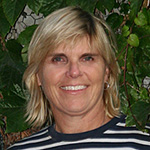Speaker Spotlight: Ann Wunderlin and Bart Pietrzak, University of Washington
Tableau users are taking their organizations (and sometimes their careers) to new heights through innovation, comprehension, and business optimization. Whatever the data, their goals are being achieved with Tableau.
Each month we will feature one of our Tableau Conference speakers in the Speaker Spotlight Q&A. You’ll learn about their past experiences at conference, what they're looking forward to, and gain a brief glimpse into the session they'll be presenting at the Tableau Conference in Seattle, September 8-12, 2014.
As a Seattle native, I'm thrilled that the Tableau Conference is coming "home" this year. It also brings me great joy to feature a local organization in the first 2014 Speaker Spotlight post. Two members of the University of Washington's Enterprise Data & Analytics team, Ann Wunderlin and Bart Pietrzak, will present on one of the largest higher education Tableau deployments. From the initial charter to the rollout and community-building, learn how this team is changing the culture of an entire university by empowering users with their data.
Tableau users are taking their organizations (and sometimes their careers) to new heights through innovation, comprehension, and business optimization. Whatever the data, their goals are being achieved with Tableau.
Each month we will feature one of our Tableau Conference speakers in the Speaker Spotlight Q&A. You’ll learn about their past experiences at conference, what they're looking forward to, and gain a brief glimpse into the session they'll be presenting at the Tableau Conference in Seattle, September 8-12, 2014.
As a Seattle native, I'm thrilled that the Tableau Conference is coming "home" this year. It also brings me great joy to feature a local organization in the first 2014 Speaker Spotlight post. Two members of the University of Washington's Enterprise Data & Analytics team, Ann Wunderlin and Bart Pietrzak, will present on one of the largest higher education Tableau deployments. From the initial charter to the rollout and community-building, learn how this team is changing the culture of an entire university by empowering users with their data.
Meet Ann Wunderlin and Bart Pietrzak, Education & Communication Manager and Business Intelligence Architect at the University of Washington, Seattle.
Tableau: How do you use Tableau in your job?
Ann: I engage with Tableau as both a user and instructor. I use Tableau to spot trends in our Business Intelligence usage, as a data profiling tool, and as a way to promote understanding among senior management regarding project effort.

Ann Wunderlin, Education &
Communication Manager
My team is also responsible for teaching Tableau Desktop and Server skills and engaging the UW Tableau community.
Bart: Our group is responsible for delivering enterprise data to the whole campus. A missing component of our offerings was the lack of collaboration environment that would allow sharing visualization among groups across campus. Tableau Server was a natural fit for our data services and the most logical approach to join many users of Tableau Desktop.

Bart Pietrzak, Business
Intelligence Architect
My team uses Tableau Server on a daily basis for publishing workbooks that we share with other groups to look at the usage of visualizations; we are also sharing visualizations in meetings to show potential project risks and project assessments as well as impact analysis for upcoming changes to our production environments. We use Tableau Desktop to build quick visualizations using database logs, data access control violations, project portfolio data to assess risk, cost and impact of projects.
Tableau: You will be giving a session at the conference, Adopting an Enterprise Standard – Piloting and Deploying Tableau at University of Washington. What can attendees to this session expect to learn? How will this help them in their career?
Ann: This session is relevant for anyone wanting to get traction on implementing Tableau in their organization. Through the various phases, including charter-writing, piloting, getting approvals, and community building, we learned many lessons. We look forward to sharing how UW became one of the largest higher education Tableau installations in the world.
Bart: We will share some of the important ingredients to make the magic sauce that helped us make the decision to use Tableau at UW. We will share what to look for when selecting a visualization tool and how we got around some of the most typical obstacles that are all too common at every higher ed institution. We will also share how we used Tableau to successfully bridge the traditional IT-business gap and delivered a product for the whole campus that met business expectation 100%.
Tableau: Have you attended Tableau Conference previously? If so, how many years ago? And what was your favorite part? If this is your first year, what are you most excited to learn, see, do?
Ann: My team began attending TCC in 2012. My first conference was TCC13. My favorite parts were the keynote speakers, the hands-on training classes, and the higher education breakout session.
Bart: I always enjoy the technical presentations and case studies.
Tableau: What advice do you have for first-year Tableau Conference attendees (or someone who is just getting started with Tableau)?
Ann: Don’t miss the keynotes, take advantage of as many hands-on training classes as possible, and network with your fellow conference attendees, especially those from your industry. Use both the mobile app and the session description notebook provided at the conference to get the most information to schedule your sessions.
Bart: Connect with others, ask questions, attend keynotes, learn.
Tableau: What dashboard or visualization are you most proud of? (Or if you don’t build dashboards, what is your favorite dashboard?)
Ann: About a year ago I produced a viz we’ve come to call Variety of Work. This viz illustrated how much of our team’s time is spent on projects outside of our core mission. It was first presented at a quarterly senior management review meeting. While we had been clicking through slides fairly quickly, when we got to this viz the presentation momentarily stopped in its tracks. Until that moment management had not seen project effort presented visually or grouped by core and non-core activities. The data had been there, but seeing it visually provided immediate and clear visibility into our work. That one visualization opened management’s eyes on how thinly we were spread and became the focus of that meeting and many discussions since. Furthermore, all other departments in our group have since been asked to produce similar vizzes.
Bart: My favorite set of dashboards is what we call UW Profiles. These dashboards present longitudinal insight into institutional data that is available to faculty and staff at UW. Tableau was a big enabler of UW Profiles as building these dashboards was much quicker as compared to the more traditional report writing tools. UW Profiles are built in a way that allow any staff or faculty member to drill through their own campus/college/department and answer most of the typical questions about students, graduation and retention rates, and degrees that are being awarded.
Tableau: If you didn’t have Tableau, what would happen?
Ann: A culture change is taking place at UW regarding data, and visualizations are integral to that. The highest levels of leadership at UW are talking about the importance of business intelligence to improve the student experience. Data visualization helps us synthesize a vast amount of data to understand admissions, enrollments, and program offerings, among many other things. Sharing these visualizations with one another on Tableau Server fosters a common understanding among decision makers and informs discussions that are based on data, not anecdote.
Bart: Without Tableau, we would have to develop a set of dashboards using our existing reporting tool. Not fun! This would require more dedicated resources and a lot of back and forth between the end user and us (UW-IT) to hash out all the details to build UW Profiles. The process would take us through many months of development and acceptance by the business. Instead, we provided the data model (Tableau extract) to the business (people who know the data) and the business created all dashboards that they thought are of the most use to the whole university. The business built all business logic into the dashboard, which we then used as a blue print to build out final data structures in the database. This approach allowed us to build 24 dashboards in a matter of weeks. Better yet, our business accepted the final product as they were the one building it!
Let us know in the comment section what else you want to hear about from each of these posts and stay tuned for next month's Speaker Spotlight.
Do you have a story to share? Apply to Speak at TCC14. And if you haven't already, you can register to attend here.
Abonnez-vous à notre blog
Recevez toute l'actualité de Tableau.



